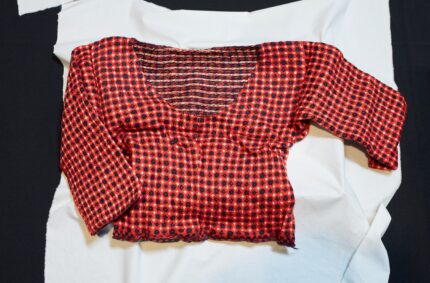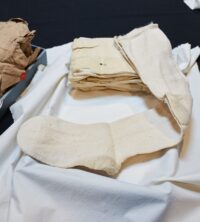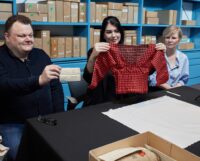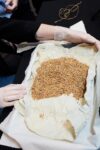
The sweater was made of fine wool in a pattern of tiny black and white florals against a vivid red background. The pattern, fitted waist, short length, half-sleeves and open neckline is very similar to the jumper of the Faroese national dress. It was sent by one Niels C. Winther of Tórshavn to Mr P Ladsen in Copenhagen with an accompanying note written in Danish stating “my wife sends her regards, thank you for the pudding rice. She sends your fiancé this sweater and hopes that it is not displeasing to her.” He described it as a “sweater for sleeping.”
Margretha Nónklett [head of ethnology at the Faroe Islands national museum] said: ‘This is a tremendously exciting find. There are very few pieces like this and we have none with this particular design. It would have been handmade at home with hand-dyed wool.’
Dr Amanda Bevan, of the National Archives, said: ’This is a rare example of a parcel surviving in the Prize Papers, which often contain letters consigned to ships for delivery by sea.’
The Winthers’ parcel sailed from Tórshavn aboard the cargo ship Anne Marie, one of two ships owned by the King of Denmark that had the monopoly of trade with the Faroes, on August 20th, 1807. The news had not yet reached the islands that the British Navy had begun the Second Battle of Copenhagen four days earlier. The British engaged in the naval battle and bombardment of Copenhagen in the attempt to seize or destroy the Danish fleet before the Danish king succumbed to French pressure to join forces with Napoleon. If neutral Denmark was swayed to the French side, the British feared its navy would their vital military and commercial access to the Baltic Sea.

A handful of those woollen stocking in Toxsvaerd’s report were found in another shipment opened at the National Archives. The parcel contained a bundle of finely knitted women’s knee-length stockings and some fabric samples. Fine woollen stockings were a top export from the Faroe Islands during this period.
Paper rix-dollars were also found among the letters, with a wad of them wrapped around 18 silver coins, which include Danish skillings dating back to the reign of Frederick III of Denmark, 1648-1670.
There are also two samples of barley being returned to sender with a note complaining about the quality of an earlier shipment: ’Out of 416 barrels of grain sent, 399 have taken some damage’. 25 barrels were so bad they couldn’t sell them, they wrote.
All of the letters and photographs of package contents from the Anne Marie will be digitized and made available in the Prize Papers database. The project is immense in scope with an estimated 3.5 million document images to be digitized and made freely available online. It will take two decades to complete.
* This article was originally published here









No comments:
Post a Comment